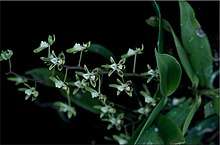Plectorrhiza brevilabris
Plectorrhiza brevilabris, commonly known as the small tangle orchid,[2] is an epiphytic or lithophytic orchid endemic to Australia. It has many coarse, wiry roots, between three and nine bright green leaves and up to twenty green, star-shaped flowers with reddish brown markings and a white patch on the labellum. It grows in rainforest on trees, shrubs and occasionally on rocks and occurs on the near coastal ranges of eastern Queensland.
| Small tangle orchid | |
|---|---|
 | |
| Plectorrhiza brevilabris on Cape York Peninsula | |
| Scientific classification | |
| Kingdom: | Plantae |
| Clade: | Tracheophytes |
| Clade: | Angiosperms |
| Clade: | Monocots |
| Order: | Asparagales |
| Family: | Orchidaceae |
| Subfamily: | Epidendroideae |
| Genus: | Plectorrhiza |
| Species: | P. brevilabris |
| Binomial name | |
| Plectorrhiza brevilabris | |
| Synonyms[1] | |
| |
Description
Plectorrhiza brevilabris is an epiphytic or lithophytic herb with a single main flattened stem, 100–500 mm (3.9–20 in) long with many coarse, wiry roots near its base. There are between three and nine dark green, leathery, narrow egg-shaped to elliptic leaves 50–80 mm (2.0–3.1 in) long and 10–15 mm (0.39–0.59 in) wide. Between three and twenty green flowers with reddish brown markings, 12–15 mm (0.47–0.59 in) long and 8–10 mm (0.31–0.39 in) wide are borne on an arching flowering stem 60–180 mm (2.4–7.1 in) long. The sepals and petals are free from each other and spread widely apart. The dorsal sepal is 3–4 mm (0.12–0.16 in) long, about 2 mm (0.079 in) wide and the lateral sepals are 5–7 mm (0.20–0.28 in) long and about 1 mm (0.039 in) wide. The petals are 4–5 mm (0.16–0.20 in) long, about 2 mm (0.079 in) wide. The labellum is green with a white patch, 6–7 mm (0.24–0.28 in) long, about 3 mm (0.12 in) wide with three lobes. The side lobes curve outwards and the middle lobe has a white, fleshy spur about 7 mm (0.28 in) long that curves downwards. Flowering occurs from November to February.[2][3]
Taxonomy and naming
The small tangle orchid was first formally described in 1880 by Ferdinand von Mueller who gave it the name Cleisostoma brevilabre and published the description in Fragmenta phytographiae Australiae.[4][5] In 1967 Alick Dockrill changed the name to Plectorrhiza brevilabris.[6] The specific epithet (brevilabris) is derived from the Latin words brevis meaning "short" and labrum meaning "lip".[7]
Distribution and habitat
Plectorrhiza brevilabris grows in rainforest on small trees, shrubs and the thinner branches of larger trees. It is found in the McIlwraith Range and in near coastal ranges and tableland south to the Noosa River.[2][3]
References
- "Plectorrhiza brevilabris". World Checklist of Selected Plant Families (WCSP). Royal Botanic Gardens, Kew.
- Jones, David L. (2006). A complete guide to native orchids of Australia including the island territories. Frenchs Forest, N.S.W.: New Holland. p. 441. ISBN 1877069124.
- "Plectorrhiza brevilabris". Trin keys: Australian Tropical Rainforest Orchids. Retrieved 28 December 2018.
- "Cleisostoma brevilabris". APNI. Retrieved 28 December 2018.
- von Mueller, Ferdinand (1880). Fragmenta phytographiae Australiae. Melbourne: Victorian Government Printer. p. 87. Retrieved 28 December 2018.
- "Plectorrhiza brevilabris". APNI. Retrieved 28 December 2018.
- Backer, C.A. (1936). Verklarend woordenboek der wetenschappelijke namen van de in Nederland en Nederlandsch-Indië in het wild groeiende en in tuinen en parken gekweekte varens en hoogere planten (Edition Nicoline van der Sijs).